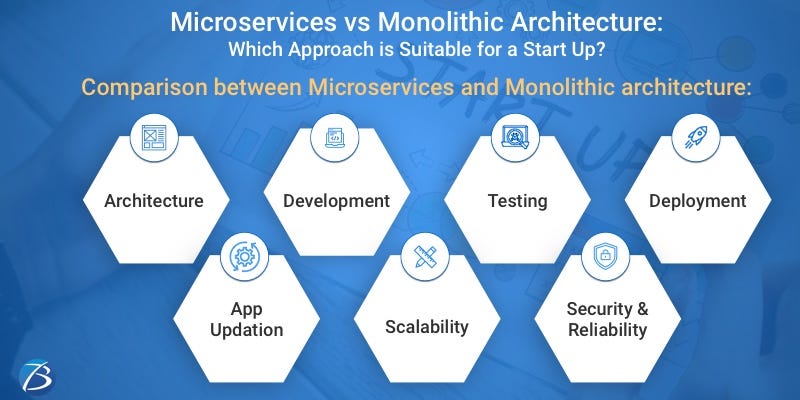Microservices vs Monolithic Architecture: Which Approach is Suitable for a Start Up?

Monolithic Architecture is a traditional approach in which the entire app is integrated into a single unified model. The prime objective is to interconnect all features making them co-dependent on each other. This model may sound simple, but creates roadblocks in handling bigger and more complex projects.
Microservices architecture, on the other hand, splits an app into smaller services that are interconnected and interact with each other with the help of APIs. Every microservice is independent, loosely coupled, and possesses a distinct hexagonal architecture comprising of business logic and different adapters. Here, each service is a separate codebase, has its own database, and can be deployed independently. This approach has gained momentum these days as modern-day businesses expect more agility in their operations. Some renowned brands using the microservices approach are Uber, Twitter, AWS, Netflix, and Spotify.
This post explores Monolithic and Microservices architecture in detail, outlines their differences and provides suggestions based on specific project requirements. A quick read will help you to pick the best-suited approach for your upcoming software development project.
Monolithic Architecture: Strengths & Weaknesses
Strengths
Monolithic apps perform speedily at the initial stages as they use local calls in place of API calls throughout the entire network. But, this speed reduces with the expansion of the app. A monolithic app, being a single solution, rather than a set of separate apps, is easily manageable, involve much lower development cost, and encounter very few cross-cutting issues initially.
Weaknesses
When the codebase of a monolithic app becomes huge, the IDE slows down, adversely affecting the developers’ productivity. Moreover, it’s challenging to scale the app, and modifying the programming language or framework that hampers the app’s functioning. Also, it’s pretty expensive to migrate to different technology in situations where monolithic architecture is used.
Microservices Architecture: Strengths & Weaknesses
Strengths
Microservice architectures are well organized - each microservice is responsible for carrying out a particular task, without being concerned about the tasks carried out by the other components. And, since such services are decoupled, they can be effortlessly reconfigured and recomposed to fulfill the needs of various microservice applications. For instance, microservices can serve public API as well as web clients.
Each microservice can be written employing a different technology; for instance, one microservice can be handled by Java developers while the other can involve DotNet developers. Thus, you have the flexibility to choose a particular technology for catering to specific business requirements without having to lock other services with that technology. This helps in optimizing the performance of crucial functions.
Microservices allows you to auto-scale an application as per the load on the app, promises speedier deployment, and eases out rolling updates as there aren’t any dependencies between the services. With this type of architecture, you can execute parallel development by setting up boundaries between various parts of the system; these boundaries are difficult to violate resulting in fewer errors.
Weaknesses
Microservices apps consume more memory; involve higher development costs initially; come with complex requirements regarding the operation, testing, deployment, and management; and need a greater level of developmental proficiency and expertise.
Microservices vs Monolithic Architecture: Comparison

Here are some major differences between Microservices and Monolithic architecture based on these crucial parameters.
Architecture
In Monolithic architecture, the app’s UI, database, business logic, front-end, and back-end are integrated into a single codebase; whereas in microservices architecture, all the aforesaid app elements are subdivided and operated independently of each other. Likewise, the processes of testing and deployment are executed under one line in monolithic apps, while in microservices apps, these processes are scattered across different adapters and databases.
Monolithic architecture is deployed in a traditional format and caters to standard web servers. For deploying microservices, on the other hand, a plethora of approaches are supported - One service-One host approach (each service is deployed to one virtual host machine); One Service-One Container approach (microservices are isolated by docker containers, but resources like frameworks, libraries, and operating servers are shared); and Serverless deployment (third-party cloud services host and manage the servers on which the program runs).
Development
Developing a monolithic application is easy if the app is new, but as the app gets bigger developmental challenges crop up. This is because the huge indivisible database needs the joint effort of the development team.
Microservices, on the other hand, offer loose coupling and several options to choose from while picking the tech stack; but the app developers must possess a more profiled knowledge. However, this structure allows developers to work independently on each component.
Testing
Testing is pretty simple in a monolithic app as a single script is used for testing the whole system while testing a microservices application becomes complex as every part of the app needs to be tested separately.
Deployment
Microservices architecture enables continual development and deployment as every service gets individually implemented. With monolithic architecture, deployment becomes slower.
App Updation
The process of updating a microservices application happens uninterruptedly and doesn’t slow down the entire system. Contrarily, updating a monolithic app is voluminous and burdensome and for every update, the entire app has to be redeployed.
Scalability
The bigger the monolithic app the more challenging it becomes to scale the app - for handling new changes the entire system has to be redeployed. In microservices apps, each part is scaled independently without downtime and so, involves fewer hassles while carrying out modifications.
Security and Reliability
Monolithic architecture involves a single source code; communication happens within a single unit, resulting in secure data processing and a simple monitoring procedure. Microservices architecture, contrarily, involves inter processing between multiple API connections increasing security threats, and hence, greater security monitoring is needed. However, in monolithic apps, one bug can hamper the whole system, while in microservices apps, one bug affects only that specific service and the bug can be topically fixed. Therefore, even when one service fails other services are not affected.
When should you pick Monolithic Approach?
You intend to develop a Simple App with faster Time-to-market
Monolithic architecture is an ideal choice for building a simple app that doesn’t require reinventing the wheel and the app is unlikely to scale rapidly. Moreover, developing the prototype of a simple app will take place at a fast pace leading to quicker time-to-market.
Smaller-sized Team and No prior Experience with Microservices
Start-ups with smaller-sized teams will benefit from the monolithic approach as experience and expertise in one tech stack will suffice and your team will not have to handle any developmental complexities. Furthermore, if your team doesn’t have any prior experience of working with microservices, picking this approach will be a risky business. In such a scenario, it’s better to start with a monolithic approach and migrate to microservices later on as and when needed.
Your app idea is Novel, Unproven, or the Proof of a Concept
If you have a novel app idea or planning to create a product that is unproven, your application is likely to evolve with time. Here, a monolithic approach will help in iterating the product speedily. Similarly, if your intended app is all set to prove a particular concept, you need to learn more within a short time and monolithic architecture will prove beneficial.
When should you pick Microservices Approach?
Your app is Complex and needs unprecedented Scaling
If you wish to develop a complicated software solution that involves a rich feature set, a substantial amount of personalization, extensive use of interactivity, a huge amount of business logic, or needs to be run by various modules; microservices architecture is your ideal pick. Start-ups who plan to build a highly innovative and revolutionary app that targets a humongous audience base and comes with heavy scaling requirements are recommended to adopt the microservices approach.
Need for Isolated Service Delivery
Microservices work better if you need to deliver independent services speedily. However, for this, you need a sufficient amount of resources as well.
A part of your Platform needs High Efficiency
For instance, your business is intensively processing petabytes of log volume. In such a scenario, you’ll have to create a service with a super-efficient programming language like C++ whereas the users’ dashboard can be created in Ruby on Rails.
Effortless Team Extension
If you commence your start-up with microservices architecture, your team will get accustomed to the idea of developing small services right from the very beginning and the teams will be segregated by service boundaries. So, later on, you can effortlessly scale up your team as per the need.
When is it advisable to migrate to Microservices Architecture?
It’s time to migrate to microservices architecture when your monolithic app grows big enough to create maintainability issues, when your business functions and their boundaries are crystal clear enough to be converted into individual services, and when your app needs scaling to deal with a humongous user load.
Example: The popular app Netflix started as a monolithic application. With time, the app experienced a surge in the demand leading to issues concerning performance and reliability. As such, the owners migrated their app to the cloud-based microservices architecture. Consequently, the app got segregated into hundreds of microservices and this approach enabled boundless expansion and scaling.
Summing Up:
Monolithic architecture as well as microservices architecture comes with its own set of strengths and challenges. So, when deciding on the most suitable pick for your start-up, you need to first define the requirements of your software development project. If you plan to develop a lightweight app and have budgetary constraints, it’s advisable to go with the monolithic approach. But, if your project is huge with complex requirements or you need to work with futuristic models like Big data, and you can spend on hiring several cross-functional teams, microservices is the most viable option.
If you want to adopt microservices or monolithic architecture, but lack the necessary in-house infrastructure, partner with the distinguished mobile app development company, Biz4Solutions. We would remain your trusted partner throughout the product lifecycle - from app ideation to development to maintenance post-deployment. We have helped several clients from diverse domains across the globe since the last 10+ years to achieve their business objectives.
Other articles and publications:
Articles and publications of other companies:
- +1 (469) 277-0804
- 8305 Tripoli Trl, Frisco, TX 75034, United States
- www.biz4solutions.com/






